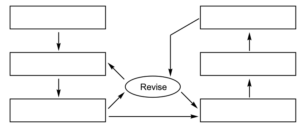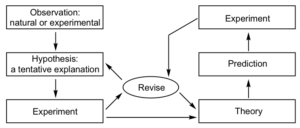Chapter 1. Chemistry: An Experimental Science
1.5 End of Chapter Problems
1. Fill in the flowchart with the following terms related to the scientific method so that it illustrates the proper order of the steps. Terms: Prediction, Hypothesis, Theory, Experiments, Observation, Experiments.

2. Consider three samples of H2O: 1g of ice, 1g of water and 1g of vapor. How do the volumes of these samples compare with one another? How is the volume related to the physical state?
3. Classify the following either a physical change, physical property, chemical change or chemical property:
a) Oxygen is a gas
b) Dry ice sublimes (goes directly from a solid to a gas)
c) A bottle of wine turning to vinegar
d) Sugar dissolving in water
e) Acid produced by bacteria can cause tooth decay
4. Correct the following statements:
a) Elements in a period have similar chemical properties.
b) In the modern periodic table, the elements are arranged in order of increasing atomic mass.
c) Elements can be classified as either metalloid or nonmetal/
5. Clearly explain the similarities and differences between molecules and mixtures.
6. How are elements and compounds similar? How are they different?
7. How are compounds and molecules similar? How are they different?
8. How are compounds and mixtures similar? How are they different?
9. Classify each of the following using as many terms as are applicable from this list: element, compound, molecule, homogeneous mixture, heterogeneous mixture, pure substance.
a) sugar b) pure apple juice c) oxygen gas in air d) distilled water
Answers:
1.

2. The volume of the vapor will be the largest, as it contains the most empty space. The volume of the liquid will be the next largest, and the volume of the solid will be the smallest because atoms are tightly packed in a solid (thus very little empty space).
3. a) physical property b) physical change c) chemical change d) physical change e) chemical property
4. a) Elements in a periodgrouphave similar chemical properties.
b) In the modern periodic table, the elements are arranged in order of increasing atomic massnumber.
c) Elements can be classified as either metalloid or nonmetal or metal
5. Both molecules and mixtures contain more than one thing. Molecules contain more than one atom, whereas mixtures contain more than one substance. A molecule is a pure substance, whereas a mixture is not. In a molecule, the “things” (atoms) are bonded, where as in a mixture they are not. A molecule has a fixed ratio of “things” (atoms), whereas a mixture has a variable ratio.
6. Both are pure substances (hence have fixed composition) but compounds contain more than one element bonded together, whereas elements contain only one type of atom.
7. Both contain fixed ratios of bonded atoms (at least 2 atoms), but compounds must contain >1 type of element, whereas molecules CAN be 2 or more of the same element. All compounds are molecules but not all molecules are compounds.
8. Both contain more than 1 substance, but compounds are bonded, whereas mixtures are not AND compounds must have a FIXED RATIO (fixed composition, as they are a pure substance) whereas mixtures can have variable composition (are NOT pure substances!)
9. a) pure substance, compound, exists as molecules
b) homogeneous mixture
c) element, exists as molecules (O2), pure substance
d) molecule, compound, pure substance

